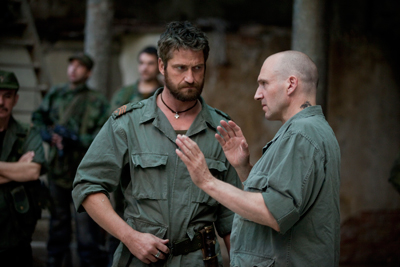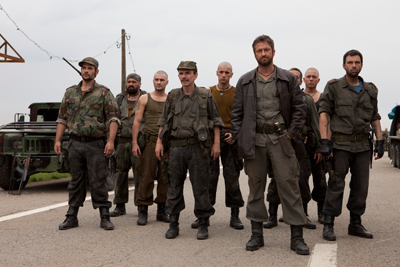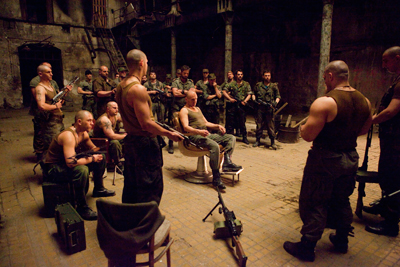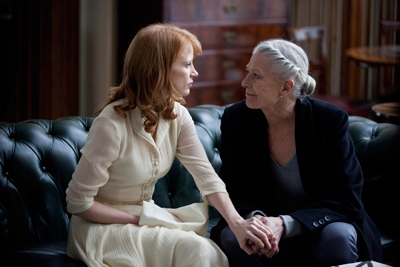Gerard Butler & Ralph Fiennes Coriolanus

Coriolanus
Cast: Gerard Butler, Ralph Fiennes, Biran Cox, Jessica Chastain, Vanessa RedgraveDirector: Ralph Fiennes
Genre: Drama, History, Thriller
Running Time: 122 minutes
Synopsis: The common people of Rome are hungry - never has the social inequality between themselves and the wealthy ruling classes been so apparent. Riots are widespread and the people's fury rapidly becomes focused on the Republic's most courageous general, Caius Martius (FIENNES), who has publicly expressed his scorn for their suffering.
But, Rome is also at war with Volsces, a neighbouring state whose guerrilla-style army is led by Martius's sworn enemy, Tullus Aufidius (Gerard Butler). Following the latest, brazen Volscian taunt, Martius and his comrade-at-arms Titus Lartius (Dragan Micanovic) are called to a council of war by their commanding officer, General Cominius (John Kani). Rome must retaliate. Martius's outstanding courage and leadership on the field of battle secures the city of Corioles for Rome. It is a crushing defeat for the Volscians and, in honour of his victory, Martius is awarded the title 'Coriolanus', meaning conqueror of Corioles. The anger of the Roman people has now subsided and Coriolanus has become a hero.
With his recent triumph, Coriolanus's politically ambitious mother Volumnia (Vanessa Redgrave) joyfully anticipates her son being elected to the powerful Senate position of Consul. Influential Roman Senator, and Coriolanus's political mentor, Menenius (Brian Cox) encourages him. Always in the background, Coriolanus's gentle and loving wife, Virgilia (Jessica Chastain), worries for her husband's continued safety.
To become Consul, Coriolanus knows he must first secure the people's support and at first he is loath to engage in the necessary glad-handing. He sees it hypocritical, an affront to his personal honour code. Under pressure, he finally relents but, not a natural politician; he handles his canvassing without the required grace and arouses ill feeling in his audience. His past public declarations have already established him as a threat to the people in the minds of their representatives, the Tribunes. And now the conspiratorial Tribunes, Brutus (Paul Jesson) and Sicinius (James Nesbitt) take advantage of Coriolanus's rapid fall from favour to persuade voters to refuse him the office he seeks. The Tribunes campaign is further supported by an underground group of left-wing rebels, led by Cassius (Ashraf Barhom) and Tamora (Lubna Azabal), who speak out against Coriolanus's election. Their combined arguments work and he is defeated.
Coriolanus is enraged and his verbal retaliation leads to further rioting. Publicly disgraced, he is banished from Rome by the Senate. Now stateless and seeking revenge for Rome's ingratitude and treachery, Coriolanus journeys to the city of Antium, the Volscian capital and home to his enemy, Tullus Aufidius. With nothing to lose, he searches out his old adversary and boldly offers him a choice. Aufidius can either take Coriolanus's life or accept his help in defeating Rome. Confronted by his greatest enemy, Aufidius must decide whether finally to destroy his rival or join forces with him in battle....
Coriolanus
Release Date: February 23rd, 2012
 Coriolanus is a tense and timeless political thriller based around power broking, political manipulation and arguments and prejudices of opposing social extremes. The backdrop is a republic caught up in a long and bitter war. But at its heart is the personal journey of Caius Martius, the noble, but complex, Coriolanus. His honour, courage and confident self-belief- all carefully nurtured and conditioned by his mother and central to his success as a great military leader - are also the eventual cause of his destruction. His frustration and anger at the pressures placed upon him to compromise his political and social principles is his great tragedy. The hero's personal and political struggles, and the state of the society in which he lives, are as relevant now as when the play, and Plutarch's original source story, were written.
Coriolanus is a tense and timeless political thriller based around power broking, political manipulation and arguments and prejudices of opposing social extremes. The backdrop is a republic caught up in a long and bitter war. But at its heart is the personal journey of Caius Martius, the noble, but complex, Coriolanus. His honour, courage and confident self-belief- all carefully nurtured and conditioned by his mother and central to his success as a great military leader - are also the eventual cause of his destruction. His frustration and anger at the pressures placed upon him to compromise his political and social principles is his great tragedy. The hero's personal and political struggles, and the state of the society in which he lives, are as relevant now as when the play, and Plutarch's original source story, were written.Filming Shakespeare's Flawed Hero
In 2000, Ralph Fiennes played the title role of Coriolanus on the London stage in a production directed by Jonathan Kent for the Almeida Theatre at the Gainsborough Studios. For Fiennes it led to what he describes as something of an obsession. "Although it's a dense play and textually difficult in its original form, I thought that its narrative drive would lend itself to film and the thought stayed, and developed, in my mind." The play's dramatic scope takes the audience from the height of bloody battle to intense political in-fighting to intimate domestic moments - all modern life is there. But the key to getting Coriolanus made was making the play accessible to the wider modern cinema audience by updating its setting and interpretation.
A few years down the line, Ralph Fiennes had developed a strong vision of what he wanted to do, but an introduction by his US agent to celebrated playwright and screenwriter John Logan was the first step in making the project a reality. Logan says "We saw the play in exactly the same way - raw and contemporary. Neither of us was interested in doing a polite 'museum-piece'. Why bother? The movie had to work first and foremost as modern cinema. In essence what Ralph Fiennes and I were always trying to capture was the way the play makes you feel in the theatre: it hits you like a fist." They talked through every line and scene in what John Logan describes as "excruciating and exhilarating detail", deciding what to cut and how to move the story on at a cinematic pace. Ralph Fiennes says "We filleted out a lot of complicated and difficult passages, but we've kept those that are important - I think that it would be crazy to totally eviscerate some of the majestic moments and tougher passages that are so stunning." As one of Shakespeare's later plays, Coriolanus is written in a dense and rich poetic language which was an advantage to modern interpretation and delivery, and ruthless editing created a cinematic lucidity for the text. Scenes were created to link the action and to allow a cinema audience to see what is only suggested on stage. And the play's First and Second Citizens became the higher profile characters of the political activists Cassius and Tamora. But the updating of the story to the 21st Century was easily embraced through a modern setting and its natural reflection of the world's current political and social climate.
Following an initial fall out of funding, Ralph Fiennes' enthusiasm, determination and vision for the project remained and the script, plus an impressive mood reel, saw producers Gabrielle Tana, Julia Taylor- Stanley and Colin Vaines come on board. Julia Taylor- Stanley comments, "The combination of Ralph Fiennes's vision and John Logan's script made us all passionate about getting the film made, but with funding for independent film becoming scarcer, the first thing we had to do was to reduce the budget. Icon agreed to come on board and I was able to find the rest of the finance that got us over the line."
 Finding Rome
Finding RomeA vital part of Ralph Fiennes' vision for the film was that 'Rome' should reflect any city anywhere in the world, both architecturally and socially. Financial and practical considerations saw him scouting all over Eastern Europe as well as considering South America, but when he saw Belgrade, Serbia he knew he had found somewhere with the weight, texture and resources he needed. Belgrade perfectly represents the extremes of the modern city: urban decay, poverty, run-down apartment blocks, bustling market places and aging industrial sites juxtapose the luxury homes of the wealthy, fashionable clubs and restaurants, modern office blocks, prestigious 19th Century civic buildings and public open spaces - stark architectural reminders of society's extremes.
Added dramatic resonance, for both cast and crew, came from the knowledge that Belgrade was the scene of much of the civil unrest brought about by the most recent Balkan conflicts. As one of the first major feature films to shoot in Serbia for many years, the production was given almost unprecedented access to locations that would have been unavailable to them elsewhere. The Serbian Parliament Building was turned into the Roman Senate for the production and the protest scenes on the Senate steps unnervingly mirrored events that took place there during the war. Filming also took place in the Hotel Jugoslavia. Once the region's premiere hotel, it was partially destroyed by the direct hit of a NATO bomb in 1999 and the bombed out part of the building was utilised for some of the battle scenes.
Serbian support for the film was outstanding. Producer, Gabrielle Tana comments "Ironically, I have a Serbian connection. My father, Dan Tana, is Serbian (and he even appears in the film as a Senator!) He was able to introduce us to a significant Serbian investor, which all dovetailed very well when Ralph Fiennes chose Belgrade. A company called Work in Progress facilitated things on the ground and we made contact with the Serbian Government, who not only got us extraordinary location access, but the Serbian army as well. That alone was an amazing contribution to the film. In fact, it was priceless as far as production value is concerned."
Casting and interpretation
'Ralph Fiennes wanted to reflect a contemporary city, which is generally multicultural and multi-lingual, so the people we brought into this picture were really important because they have a different kind of presence to what you normally get in Shakespeare on film,' says producer Colin Vaines. Ralph Fiennes worked with his actors and the film's Dialogue Coach, Joan Washington, to make speech as conversational and natural to the modern ear as possible.
Almost from the conception of the film, Vanessa Redgrave was Ralph Fiennes' choice for 'Volumnia' and, despite the early false start for the production, her dedication to playing the role remained both strong and inspirational to other cast members.
Likewise, Ralph Fiennes was set on rising young American actress, Jessica Chastain for 'Virgilia' after seeing her on stage in New York playing Desdemona in Othello. He also knew early on that he wanted renowned Shakespearian actor, Paul Jesson, for the conspiratorial career politician 'Brutus' having worked with him many times at the RSC.
UK casting Agent, Jina Jay, suggested Scottish actor Brian Cox for Coriolanus' great political mentor and friend, 'Menenius' and she also put forward well-known Irish actor James Nesbitt as the 'man of the people' Tribune, 'Sicinius'. South African John Kani, though surprised to be offered the part, was won over in seconds by Ralph Fiennes' ideas and enthusiasm for the film and happily accepted the role of soldier, politician and peacemaker, 'Cominius'.
Belgian actress Lubna Azabal and Israeli actor Ashraf Barhoum, in the roles of the two leading political activists, instantly impressed with their powerful screen presence and interpretation of their roles. And the producers were keen from the start to draw on Serbia's own highly talented pool of actors. Dragan Miéanovié, who plays 'Titus Lartius', has been seen in key roles in several international film and TV productions, but also has an award-winning career in Shakespearian theatre within Serbia. Similarly, Slavko Stimac, who plays Aufidius' Volscian Lieutenant, has a long and well established acting career.
But perhaps the most challenging role to cast was that of Coriolanus' mortal enemy, 'Tullus Aufidius'. The part demanded someone with a screen presence to match that of Ralph Fiennes' brooding and masculine warrior, as well as a strong profile in film. Gerard Butler was an obvious choice and he was keen from the first approach, not only because he could draw and expand on the experiences of his roles as 'Leonides' and 'Beowulf', but also because he could revisit Coriolanus. He took his first professional role as a young actor in Stephen Berkoff's stage production - though he hastens to say that he was only in the chorus. Gerard Butler also says, 'Aufidius is just a fantastically complex, heroic and compassionate character and I think the fact that Ralph wanted me to do the movie with him was a huge compliment.'
 Battle and Protest
Battle and Protest'The great thing about doing Shakespeare on film is that when you are sitting in row 1 3c at the theatre you get to see the scenario from a distance, but on film you get right into the action. You see these incredible close-ups and nuances - the audience becomes a silent participant in every scene,' says producer Julia Taylor-Stanley. The camera and sound work bring the audience into close contact with the characters - whether in a battle, protest, Senate chamber or a domestic setting, this sometimes unnerving intimacy draws them directly into the emotional energy and driven dialogue of the piece.
War and political unrest are central themes to the story - the one raising the hero up, the other bringing him down. The production was privileged to have been able to work with the SAJ, Serbia's prime counter-terrorist unit, in realistically bringing the battle scenes to life. Ralph Fiennes and Dragan Miéanovié trained intensively with the SAJ - learning a soldier's economy of movement, how to carry and fire weapons and how to think tactically in the heat of battle. Most of Rome's on-screen troops are also serving SAJ members and all the armoured vehicles, tanks and weaponry are real. The Corioles battle scenes vividly depict the chaos, destruction and brutality of war. A ward -winning Director of Photography Barry Ackroyd B.S.C and his camera crew filmed much of the action on handheld cameras in the thick of the battle to achieve the intensity of a soldier's point of view. It's fast moving and explosive modern warfare, much of it shot in the town of Pancevo just outside Belgrade. The locals had a week of Roman soldiers, Volscian guerrilla fighters, guns, rocket launchers, armoured vehicles, burning cars and war debris on their streets - which culminated in a dramatic scene with an exploding bus.
Coriolanus' public interaction with the people and politicians of Rome leads to equally combustible scenes of civil unrest and rioting. Again the camera crew was right in the middle of the argument, debate and intrigue between military, politicians and baying mob. Allowing all of these scenes to grow and develop organically added to the immediacy, fluidity and electric energy of political and martial conflict. The deliberately loose choreography in the scenes at the grain silos, for example, saw Barry Ackroyd with his camera right in the faces of advancing and raging protesters - but supported from behind by a camera assistant to prevent him from falling and being trampled under the feet of the advancing crowd.
Award winning Production Sound Mixer, Ray Beckett C.A.S., picked up the audio chaos of war and riot by not only putting microphones on all the key cast, but by planting 360� pick-up microphones deep within the action.
Creating the Contrasts
Ralph Fiennes had a very strong vision of how he wanted the film to look. And for the Volsce, Costume Designer Bojana Nikitovié was able to draw on recent history, not only of the Balkans, but also of continued political unrest around the world, to achieve it. The Volsce are an unkempt guerrilla force with no standardised uniform. The costume department raided army surplus stores to kit them out, but included in the range of ill - matched army fatigues are jeans, leather jackets and bandanas. The Volsce are also heavily tattooed, not only with their own insignia, but with religious iconography, skulls, guns and daggers that were specially designed for the production by Make-Up Designer, Daniel Parker. They represent not only the determination and aggression of the Volsce but also their deep spiritual belief that their cause is just. The tattoos worn by Tullus Aufidius are naturally among the most impressive.
The Roman army are a stark contrast. In the latest design of digital fatigues with the latest weaponry, they are professional soldiers, the symbol of the powerful Republic at war - uniform in both look and intent.
Production Designer, Ricky Eyres, created the two insignia to starkly represent the opposing sides. The Roman Eagle, set against a cool petrol blue, a recognisable colour of power and government. The Volscian 'blades', placed in a V are, by contrast, a more 'earthy' copper colour for the insurgent enemy. Ricky Eyres also produced visual reminders of Coriolanus' and Tullus Aufidius's differing status with their respective people. Coriolanus' stencilled face appears on protest banners carried by the poor of Rome, whereas Aufidius is seen on posters and graffiti all over Corioles - placed there by his supporters. Aufidius has celebrity status, whereas Coriolanus' face represents injustice and discontent to his people.
Ricky Eyres notes that much of his team's work was about adding stand out colour to the existing rich texture of Belgrade and Pancevo. Graffiti of all kinds played a major part in this as did, for the battle scenes, the building of some substantial structures - including the city gate of Corioles. Other major works included the construction of the truck stop 'meeting point' on an isolated and windy road in the middle of nowhere and the creation of the secret Volsce hideout in the cold, damp and dark catacombs beneath Belgrade's fort. This saw the set decoration for seven sets including a detention cell, Aufidius's quarters and a meat locker.
MORE
- Mission: Impossible Fallout
- Glenn Close The Wife
- Allison Chhorn Stanley's Mouth Interview
- Benicio Del Toro Sicario: Day of the Soldado
- Dame Judi Dench Tea With The Dames
- Sandra Bullock Ocean's 8
- Chris Pratt Jurassic World: Fallen Kingdom
- Claudia Sangiorgi Dalimore and Michelle Grace...
- Rachel McAdams Disobedience Interview
- Sebastián Lelio and Alessandro Nivola...
- Perri Cummings Trench Interview
Copyright © 2001 - Female.com.au, a Trillion.com Company - All rights reserved. 6-8 East Concourse, Beaumaris, Vic 3193, Australia.



